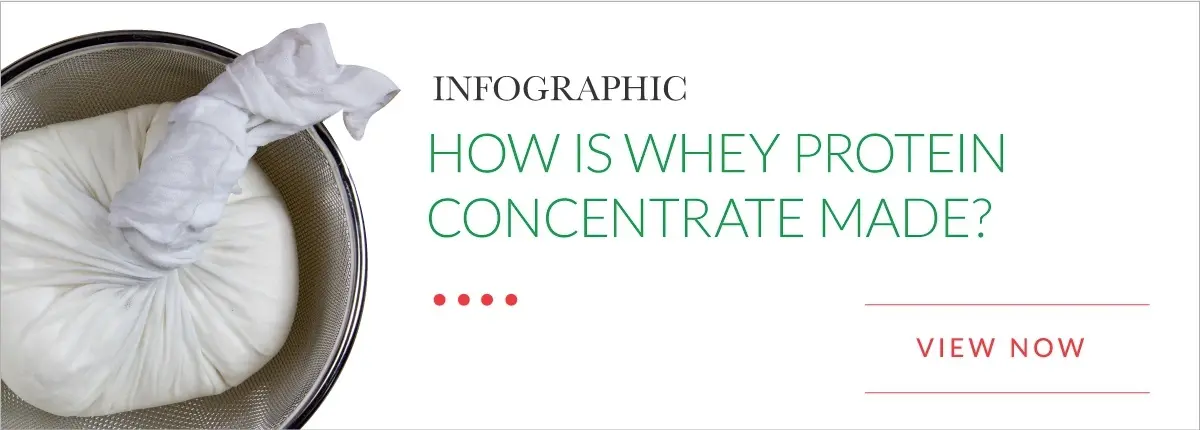
Clean-label products have been “on trend” for the last decade. In other words, they’re here to stay.
In fact, there is increased scrutiny among consumers, according to Ingredion’s 2023 research. The number of consumers who check labels and only want natural ingredients increased by about 40% in the last three years.
Whey protein products align with these consumer preferences, but some food and beverage manufacturers aren’t leveraging these versatile ingredients to their fullest.
In this article, we’ll answer commonly asked questions and provide an overview of the benefits of including whey protein on food labels, including:
- How can whey protein be used in formulations?
- Is whey protein a natural product?
- How is whey protein concentrate made?
- What is whey protein’s impact on nutritional labels?
- How can food manufacturers leverage the benefits of whey protein?
How can whey protein be used in formulations?
Functional whey proteins naturally can improve flavor, texture and nutrition in soups and sauces. Some forms can even increase yield in meat products and enhance texture and umami flavors without being labeled as a binder or filler.
Each form of whey protein provides different functionalities. For example, Grande Custom Ingredients Group features the following:
- Grande Bravo® — A functional whey protein concentrate that partially replaces high-fat, high-calorie ingredients such as heavy cream in soups, sauces, dips, dressings and other creamy applications
- Grande Gusto® — A reduced lactose whey that partially replaces fresh, processed or powdered cheese in sauces, dips, fillings and other cheesy applications
- Grande FestoTM — A hydrolyzed whey protein that helps improve texture, mouthfeel, flavor and yields in meat patties, sausages, meatballs and frozen meat product and isn’t classified as a filler or binder
- Grande Ultra® Whey protein isolate (WPI) — A high-protein WPI supplement used in nutritional foods and clear protein beverages to promote lean body mass
- Grande WPCrisp® — A crunchy, high-protein whey protein crisp ingredient used in protein bars, snacks and meal replacement bars
- Grande PrimoTM — A dried yogurt and cultured dairy product that can add authentic Greek or regular yogurt flavor with rich, creamy textures
Labeling Impact
Consumers overwhelmingly recognize and trust whey protein ingredients on labels. In one study, whey protein concentrate ranked the highest for familiarity and purchase intent compared to other powdered dairy and common plant proteins. Including whey protein on labels can help increase consumer appeal while maintaining clean labels.
Is whey protein a natural product?
As a producer of whey ingredients, we’re often asked about how they’re made and whether they qualify as clean-label. Whey protein is generally considered a wholesome ingredient because it’s derived from the traditional cheesemaking process.
But not all whey protein ingredients are created equal.
It should be noted that some commodity manufacturers chemically modify their whey protein products, negating their “all-natural” status. Grande Custom Ingredients Group, however, uses zero chemical modifications, additives, artificial colors or preservatives in its production processes, and all of our ingredients are completely natural.
Labeling Impact
All of Grande Custom Ingredients Group’s whey protein products can be labeled as “all natural.”
How is whey protein concentrate made?
At Grande Custom Ingredients Group, our production process starts with the highest-quality milk collected daily from our dedicated Midwest producer dairy farms. The majority maintain 5-star certifications from the Milk & Dairy Beef Quality Assurance Program, exceeding the government’s highest rating and providing the highest level of animal health and welfare (another aspect of concern for consumers).
Once collected, the fresh milk is rapidly cooled and delivered to our plants where it’s made into our world-class white Italian cheeses. Once we’ve gathered the natural, high-quality whey that’s left from the cheese production process, it's filtered through several membranes. Our natural proprietary process is applied to dry the whey into its various powdered forms.
This strict chain of custody is highly unusual in the whey protein powder industry, helping ensure quality and a readily available and consistent supply chain.
Labeling Impact
Historically, whey that was left from the cheesemaking process was often discarded. Now, when whey protein is included in formulations, it can be labeled as an upcycled and sustainable ingredient. In addition, all Grande products are ethically sourced from vetted dairy producers.
GET THE INFOGRAPHIC: How is Whey Protein Concentrate Made?
What is whey protein’s impact on nutritional labels?
The nutrition facts of whey protein are well documented. When replacing heavy cream or cheese in a formulation, whey protein concentrate not only improves flavor and viscosity, it positively impacts a nutrition label.
Various forms will vary slightly in their nutritional value but, in general, consumers can expect lower fat and calories, and some forms help reduce sodium. Increased protein levels can be expected with WPIs and whey crisps.
Labeling Impact
Nearly all forms of functional whey protein improve nutrition. For example, Grande Bravo reduces fat by as much as 20% and calories up to 25% in creamy formulations. Grande Gusto can reduce sodium and calories up to 15% and fat by as much as 25% in cheesy applications. Grande Ultra and Grande WPCrisp boost protein levels.
How can food manufacturers leverage the benefits of whey protein?
Food manufacturers can deliver the tastes and textures that their customers crave with Grande Custom Ingredients Group’s innovative whey ingredients. And, because they’re price stable, they can reduce the use of volatile, high-cost ingredients — a true win-win.
Explore Grande Custom Ingredients Group’s natural whey protein production process — from the farm through to the final stages — by downloading our infographic. And contact us to request samples and talk through your formulation challenges.





